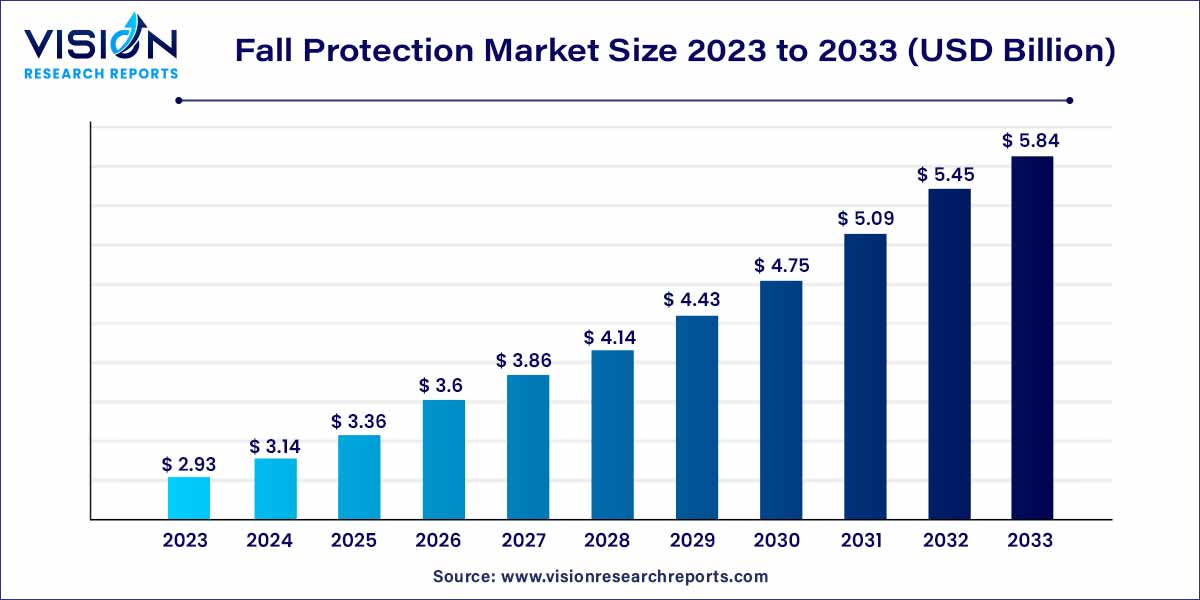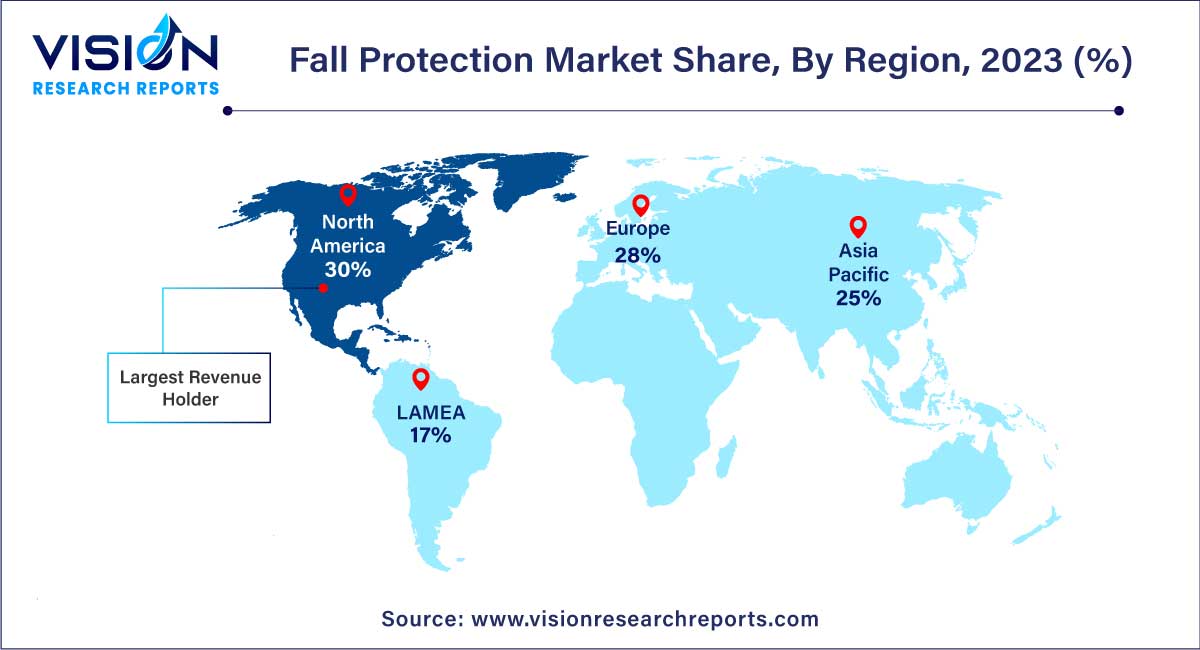The global fall protection market size was surpassed at USD 2.93 billion in 2023 and is expected to hit around USD 5.84 billion by 2033, growing at a CAGR of 7.14% from 2024 to 2033. The market is expected to grow because of the increased emphasis on employee welfare, the existence of strict workplace safety rules, and the rise in awareness of workplace safety.

The fall protection market plays a critical role in ensuring the safety of workers across various industries worldwide. With stringent regulations and growing awareness regarding workplace safety, the demand for fall protection solutions continues to rise. This overview provides insights into the key drivers, challenges, trends, and opportunities shaping the fall protection market landscape.
The growth of the fall protection market is primarily driven by several key factors. Stringent government regulations mandating safety measures in workplaces have significantly contributed to the increased adoption of fall protection solutions. Furthermore, rising awareness among employers and employees regarding the importance of workplace safety has spurred demand for advanced fall protection technologies. The expansion of the construction and industrial sectors, along with infrastructure development projects, has also created a substantial market demand. Technological advancements, such as the integration of IoT and wearable sensors, have enhanced the safety and monitoring capabilities of fall protection systems, further driving market growth. Additionally, the trend towards customization and innovation in fall protection solutions, along with the growing emphasis on sustainability, presents opportunities for market expansion and differentiation.
Integration of Advanced Technologies:
Customization and Innovation:
Emphasis on Sustainability:
Heightened Awareness and Training Initiatives:
The individual protection segment took the lead in the market, accounting for a substantial 59% revenue share in 2023. This segment is expected to continue its growth trajectory during the forecast period, driven by industries prioritizing worker safety. Furthermore, regulatory standards like OSHA, CSA, and EU 2016/425, aimed at enhancing worker safety, have become more stringent. With organizations increasingly recognizing the economic and human costs associated with workplace accidents, there's a notable uptick in investments towards advanced individual fall protection systems. This trend is expected to propel the adoption of individual fall protection systems globally over the forecast period.
Collective fall protection systems ensure the safety of individuals working on flat roofs (with a maximum inclination of 20 degrees) or atop flat machinery. This category includes guardrails, handrails, safety nets, and anchor point systems/horizontal lifeline systems. By creating a barrier between potential falling edges and individuals in high-risk areas, collective fall protection systems effectively mitigate dangers, providing comprehensive protection to workers in elevated positions.
The construction segment has exhibited significant growth from 2024 to 2033, fueled by the robust expansion of the construction industry worldwide. Factors such as urbanization, infrastructure development, and population growth contribute to this growth trajectory. Particularly in the context of high-rise buildings, bridges, and other elevated structures, workers face considerable fall hazards. Consequently, there's a heightened awareness within the construction industry regarding the occupational risks associated with working at heights. Both employers and workers recognize the imperative for comprehensive fall protection measures to mitigate these risks effectively. This growing awareness drives the demand for advanced and reliable fall protection solutions.
In the manufacturing sector, fall protection holds paramount importance due to the potential exposure of workers to elevated work surfaces, machinery, and other fall hazards. Within this sector, there's a rising acknowledgment of the significance of adhering to safety standards. Manufacturers are increasingly cognizant of the necessity for robust fall protection solutions to address the risks inherent in working at heights. This awareness has resulted in a greater adoption rate of safety equipment and systems within the manufacturing industry
North America emerged as the market leader with a commanding revenue share of 30% in 2023, with the United States and Canada serving as the primary revenue contributors. The region's market is witnessing robust revenue growth driven by escalating concerns for worker safety, early adoption of advanced technology, and stringent regulations mandating the use of fall protection equipment across various industries such as construction, oil & gas, and manufacturing. In manufacturing facilities, where establishing stable anchor points is challenging, fall protection systems play a crucial role in mitigating fall risks in elevated work environments. Rigid rail fall arrest systems, in conjunction with self-retracting lifelines, serve as dependable solutions for fall safety in these facilities.

The construction sector in the Asia Pacific region has experienced significant growth over the past decade. With a burgeoning population requiring housing, education, and healthcare facilities, there has been a substantial influx of investments from both public and private sectors to meet this escalating demand. Moreover, the economic expansion witnessed in countries like India, China, and Southeast Asian nations has intensified the need for enhanced public infrastructure, encompassing roadways, harbors, airports, and rail transport systems. For instance, in January 2023, China's National Development and Reform Commission (NDRC) greenlit a total of 109 fixed asset investment projects, amounting to a colossal investment of USD 21.08 billion.
By Type
By End-use
By Region
Chapter 1. Introduction
1.1. Research Objective
1.2. Scope of the Study
1.3. Definition
Chapter 2. Research Methodology
2.1. Research Approach
2.2. Data Sources
2.3. Assumptions & Limitations
Chapter 3. Executive Summary
3.1. Market Snapshot
Chapter 4. Market Variables and Scope
4.1. Introduction
4.2. Market Classification and Scope
4.3. Industry Value Chain Analysis
4.3.1. Raw Material Procurement Analysis
4.3.2. Sales and Distribution Channel Analysis
4.3.3. Downstream Buyer Analysis
Chapter 5. COVID 19 Impact on Fall Protection Market
5.1. COVID-19 Landscape: Fall Protection Industry Impact
5.2. COVID 19 - Impact Assessment for the Industry
5.3. COVID 19 Impact: Global Major Government Policy
5.4. Market Trends and Opportunities in the COVID-19 Landscape
Chapter 6. Market Dynamics Analysis and Trends
6.1. Market Dynamics
6.1.1. Market Drivers
6.1.2. Market Restraints
6.1.3. Market Opportunities
6.2. Porter’s Five Forces Analysis
6.2.1. Bargaining power of suppliers
6.2.2. Bargaining power of buyers
6.2.3. Threat of substitute
6.2.4. Threat of new entrants
6.2.5. Degree of competition
Chapter 7. Competitive Landscape
7.1.1. Company Market Share/Positioning Analysis
7.1.2. Key Strategies Adopted by Players
7.1.3. Vendor Landscape
7.1.3.1. List of Suppliers
7.1.3.2. List of Buyers
Chapter 8. Global Fall Protection Market, By Type
8.1. Fall Protection Market, by Type, 2024-2033
8.1.1. Individual Protection
8.1.1.1. Market Revenue and Forecast (2021-2033)
8.1.2. Collective Protection
8.1.2.1. Market Revenue and Forecast (2021-2033)
8.1.3. Access Equipment
8.1.3.1. Market Revenue and Forecast (2021-2033)
Chapter 9. Global Fall Protection Market, By End-use
9.1. Fall Protection Market, by End-use, 2024-2033
9.1.1. Construction
9.1.1.1. Market Revenue and Forecast (2021-2033)
9.1.2. Manufacturing
9.1.2.1. Market Revenue and Forecast (2021-2033)
9.1.3. Oil & Gas
9.1.3.1. Market Revenue and Forecast (2021-2033)
9.1.4. Chemicals
9.1.4.1. Market Revenue and Forecast (2021-2033)
9.1.5. Food
9.1.5.1. Market Revenue and Forecast (2021-2033)
9.1.6. Pharmaceuticals
9.1.6.1. Market Revenue and Forecast (2021-2033)
9.1.7. Healthcare
9.1.7.1. Market Revenue and Forecast (2021-2033)
9.1.8. Transportation
9.1.8.1. Market Revenue and Forecast (2021-2033)
9.1.9. Mining
9.1.9.1. Market Revenue and Forecast (2021-2033)
9.1.10. Others
9.1.10.1. Market Revenue and Forecast (2021-2033)
Chapter 10. Global Fall Protection Market, Regional Estimates and Trend Forecast
10.1. North America
10.1.1. Market Revenue and Forecast, by Type (2021-2033)
10.1.2. Market Revenue and Forecast, by End-use (2021-2033)
10.1.3. U.S.
10.1.3.1. Market Revenue and Forecast, by Type (2021-2033)
10.1.3.2. Market Revenue and Forecast, by End-use (2021-2033)
10.1.4. Rest of North America
10.1.4.1. Market Revenue and Forecast, by Type (2021-2033)
10.1.4.2. Market Revenue and Forecast, by End-use (2021-2033)
10.2. Europe
10.2.1. Market Revenue and Forecast, by Type (2021-2033)
10.2.2. Market Revenue and Forecast, by End-use (2021-2033)
10.2.3. UK
10.2.3.1. Market Revenue and Forecast, by Type (2021-2033)
10.2.3.2. Market Revenue and Forecast, by End-use (2021-2033)
10.2.4. Germany
10.2.4.1. Market Revenue and Forecast, by Type (2021-2033)
10.2.4.2. Market Revenue and Forecast, by End-use (2021-2033)
10.2.5. France
10.2.5.1. Market Revenue and Forecast, by Type (2021-2033)
10.2.5.2. Market Revenue and Forecast, by End-use (2021-2033)
10.2.6. Rest of Europe
10.2.6.1. Market Revenue and Forecast, by Type (2021-2033)
10.2.6.2. Market Revenue and Forecast, by End-use (2021-2033)
10.3. APAC
10.3.1. Market Revenue and Forecast, by Type (2021-2033)
10.3.2. Market Revenue and Forecast, by End-use (2021-2033)
10.3.3. India
10.3.3.1. Market Revenue and Forecast, by Type (2021-2033)
10.3.3.2. Market Revenue and Forecast, by End-use (2021-2033)
10.3.4. China
10.3.4.1. Market Revenue and Forecast, by Type (2021-2033)
10.3.4.2. Market Revenue and Forecast, by End-use (2021-2033)
10.3.5. Japan
10.3.5.1. Market Revenue and Forecast, by Type (2021-2033)
10.3.5.2. Market Revenue and Forecast, by End-use (2021-2033)
10.3.6. Rest of APAC
10.3.6.1. Market Revenue and Forecast, by Type (2021-2033)
10.3.6.2. Market Revenue and Forecast, by End-use (2021-2033)
10.4. MEA
10.4.1. Market Revenue and Forecast, by Type (2021-2033)
10.4.2. Market Revenue and Forecast, by End-use (2021-2033)
10.4.3. GCC
10.4.3.1. Market Revenue and Forecast, by Type (2021-2033)
10.4.3.2. Market Revenue and Forecast, by End-use (2021-2033)
10.4.4. North Africa
10.4.4.1. Market Revenue and Forecast, by Type (2021-2033)
10.4.4.2. Market Revenue and Forecast, by End-use (2021-2033)
10.4.5. South Africa
10.4.5.1. Market Revenue and Forecast, by Type (2021-2033)
10.4.5.2. Market Revenue and Forecast, by End-use (2021-2033)
10.4.6. Rest of MEA
10.4.6.1. Market Revenue and Forecast, by Type (2021-2033)
10.4.6.2. Market Revenue and Forecast, by End-use (2021-2033)
10.5. Latin America
10.5.1. Market Revenue and Forecast, by Type (2021-2033)
10.5.2. Market Revenue and Forecast, by End-use (2021-2033)
10.5.3. Brazil
10.5.3.1. Market Revenue and Forecast, by Type (2021-2033)
10.5.3.2. Market Revenue and Forecast, by End-use (2021-2033)
10.5.4. Rest of LATAM
10.5.4.1. Market Revenue and Forecast, by Type (2021-2033)
10.5.4.2. Market Revenue and Forecast, by End-use (2021-2033)
Chapter 11. Company Profiles
11.1. FallTech
11.1.1. Company Overview
11.1.2. Product Offerings
11.1.3. Financial Performance
11.1.4. Recent Initiatives
11.2. Petzl
11.2.1. Company Overview
11.2.2. Product Offerings
11.2.3. Financial Performance
11.2.4. Recent Initiatives
11.3. SKYLOTEC
11.3.1. Company Overview
11.3.2. Product Offerings
11.3.3. Financial Performance
11.3.4. Recent Initiatives
11.4. WernerCo
11.4.1. Company Overview
11.4.2. Product Offerings
11.4.3. Financial Performance
11.4.4. LTE Scientific
11.5. Guardian Fall
11.5.1. Company Overview
11.5.2. Product Offerings
11.5.3. Financial Performance
11.5.4. Recent Initiatives
11.6. MSA
11.6.1. Company Overview
11.6.2. Product Offerings
11.6.3. Financial Performance
11.6.4. Recent Initiatives
11.7. Honeywell International Inc
11.7.1. Company Overview
11.7.2. Product Offerings
11.7.3. Financial Performance
11.7.4. Recent Initiatives
11.8. 3M
11.8.1. Company Overview
11.8.2. Product Offerings
11.8.3. Financial Performance
11.8.4. Recent Initiatives
11.9. Gravitec Systems, Inc
11.9.1. Company Overview
11.9.2. Product Offerings
11.9.3. Financial Performance
11.9.4. Recent Initiatives
11.10. Kee Safety Inc
11.10.1. Company Overview
11.10.2. Product Offerings
11.10.3. Financial Performance
11.10.4. Recent Initiatives
Chapter 12. Research Methodology
12.1. Primary Research
12.2. Secondary Research
12.3. Assumptions
Chapter 13. Appendix
13.1. About Us
13.2. Glossary of Terms
 Cross-segment Market Size and Analysis for
Mentioned Segments
Cross-segment Market Size and Analysis for
Mentioned Segments
 Additional Company Profiles (Upto 5 With No Cost)
Additional Company Profiles (Upto 5 With No Cost)
 Additional Countries (Apart From Mentioned Countries)
Additional Countries (Apart From Mentioned Countries)
 Country/Region-specific Report
Country/Region-specific Report
 Go To Market Strategy
Go To Market Strategy
 Region Specific Market Dynamics
Region Specific Market Dynamics Region Level Market Share
Region Level Market Share Import Export Analysis
Import Export Analysis Production Analysis
Production Analysis Others
Others